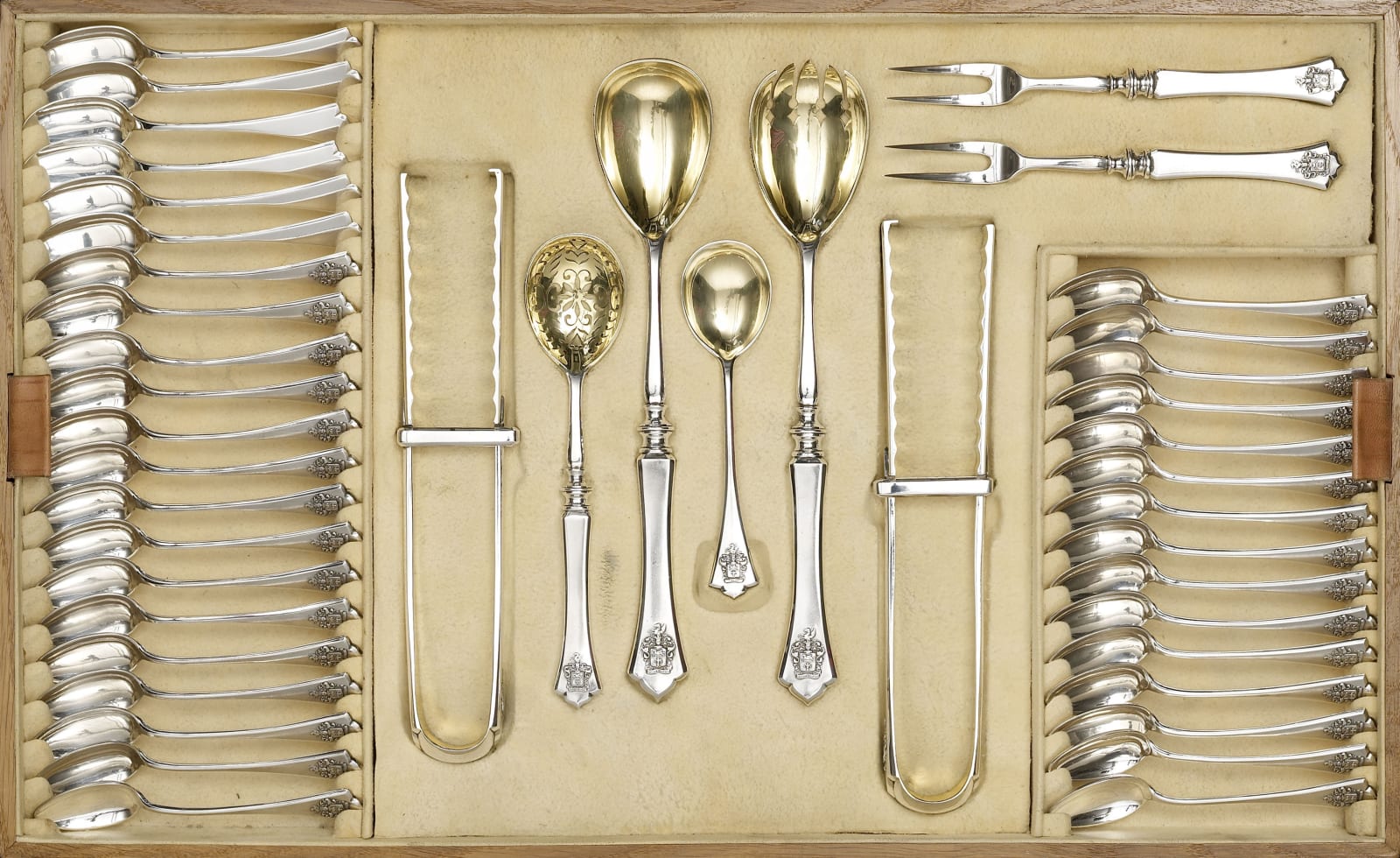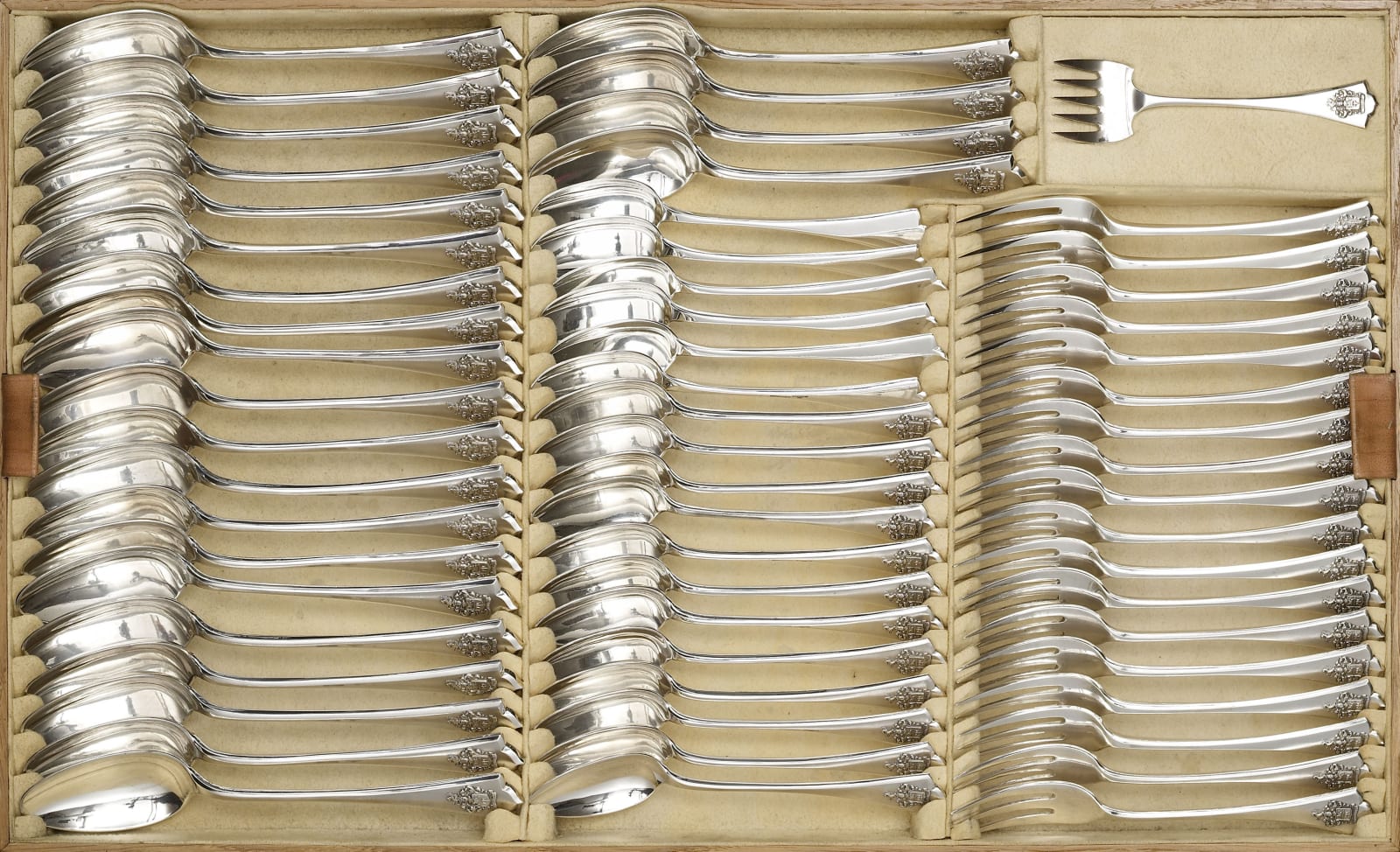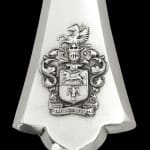Carl Fabergé 1846-1920
Further images
A very large and fine Russian canteen of silver and silver gilt cutlery by Fabergé, each piece bearing the coat of arms for the Barthèlmes or Bartholomaei family and bearing the motto Per Aspera ad Astra, in the original case bearing the arms of the Barthèlmes family stamped on the cream silk lining with the Carl Fabergé name in Cyrillic characters below the double headed eagle. The service consisting of a total of 211 pieces comprising 36 small spoons (of which 6 are new), 18 dessert forks, 18 dessert spoons (of which 6 are new), 24 large spoons, 30 large forks, 18 coffee spoons (of which 6 are new), 18 cheese knives, 30 large knives, with blades by Joseph Rodgers & Sons appointed to Her majesty, made for Fabergé of Moscow, 2 asparagus tongs, a serving fork with five prongs, a serving spoon, an olive spoon, two carving forks with two prongs, a carving knife, an extra place setting, 4 large serving spoons, a fruit knife and 4 tart servers
Moscow, dated 1893
Each piece fully hallmarked.
The arms on the cutlery are ascribed in Rietstap's Armorial Générale as belonging to the house of Barthèlmes or Bartholomaei, who were a noble Silesian family ennobled by the Holy Roman Emperor on 16th August 1585. The Latin motto Per Aspera ad Astra, literally means through hardship to the stars. The phrase is also the motto of the house of Mecklenburg-Schwerin.
This luxurious service was made in the Fabergé Moscow workshop, which specializing in the production of silver and glassware was opened in 1887. The more important and large silver services as well as objects such as animals and trophies made in Moscow were the work of Fabergé's head silversmith, Julius Rappoport (1864-1916), who was almost certainly responsible for the creation of the present canteen. Of universal renown, the name of Carl Fabergé (1846-1920) has become synonymous with perfect craftsmanship, superior design and fine taste. Fabergé objects continue to be prized by the discerning and are to be found among royal and eminent private collections as well as museums worldwide.
Carl (christened Peter Carl) was born in St. Petersburg, the eldest son of Gustav Fabergé, a master jeweller and Charlotte Jungstedt, daughter of a Danish painter. His father's family, of French Huguenot descent, left France in 1685. For several generations they lived in North East Germany, and then moved to Pernau in Estonia where Gustav was born in 1814. By the early 1840's, Gustav Fabergé had moved to St. Petersburg, where he was married in 1842. In the same year, he opened a silver and jewellery shop in Bolshaya Morskaya Street in the centre of the city. On his retirement in 1870, the business was taken over by the 24-year-old Carl, who rapidly transformed the small conventional business into Russia and one of Europe's most fashionable silver and jewellery house.
Having trained in his hometown under his father's friend the goldsmith and jeweller, Peter Perdin, Carl Fabergé's subsequent travels to Western Europe proved an inspiration to a number of the firm's designs. The principle influence was the Louis XV rococo style, the classical elements of Louis XVI and Empire design and later more naturalistic elements of Art Nouveau. Fabergé was also inspired by Far Eastern and native Russian designs though the novelty objects such as the Imperial Eggs, miniature furniture pieces or flowers in rock-crystal vases were of his own unique inspiration.
Fabergé had a remarkable skill for organization and at one time employed over 500 artists and craftsmen. In 1882, his younger brother, Agathon from Dresden, joined him as a jewellery designer, while Carl continued to act as the artistic and commercial director. The technical management was entrusted to his head workmasters, successively notably Erik Kollin (1870-86), Mikhail Perchin (1886-1903) and then Henrik Wigström (1903-18), who experimented with a rich variety of stones and multi-coloured golds and perfected their enamelling techniques to an unrivalled level. Fabergé only designed the most important objects himself, such as the 54 Imperial Easter Eggs, which Tsar Alexander III presented to his wife and subsequently Tsar Nicholas II to both his wife and mother. As his success grew, Fabergé was later to supply royalty from the Far East and Europe as well as Edwardian aristocracy.
The House of Fabergé exhibited at a number of international exhibitions, frequently winning awards. At their debut at the Pan-Russian Exhibition, 1882 and again at Nuremburg, 1885 they were awarded gold medals. When the Imperial Eggs were shown in Paris at the Exposition Universelle in 1900, Fabergé was subsequently decorated with the Légion d'Honneur. Success led to business expansion; branches were opened in Moscow (1887), Odessa (1890-1918), Kieve (1905-10) and London (1903-15).
However the Bolshevik Revolution of 1917 brought an end to the Fabergé reign. In 1918 the House of Fabergé was closed down, the Imperial collection sold, Fabergé fled with his family to Germany and then to Switzerland, where he died at the Hotel Bellevue in Lausanne on 24th September 1920. But his outstanding repute never died since every object that left his workshop was of breathtaking quality. As his biographer, Kenneth Snowman wrote, "it may be claimed that any object which is not immaculately made and highly finished in every detail cannot be by Fabergé at all".
THE HOUSE OF FABERGE.RUSSIAN FOUNDED IN 1842 AND FLOURISHED UNDER PETER CARL FABERGE (1846-1920)
Peter Carl Faberge is associated with perfect craftsmanship, superior design and fine taste. Faberge objects continue to be prized by the discerning and are to be found among royal and eminemt private collections as well as world museums. The firm had modest beginnings: in 1842, Gustave Faberge, of French Huguenot descent opened a silver and jewellery shop in St. Petersburg, which in 1870 was taken over by his 24 year old son, Peter Carl (b. St. Petersburg), who rapidly transformed the small and conventional business into Russia's and one of Europe's most fashionabel house of jewellery. He had a remarkable skill for organisation and at one time employed over 500 artistes and crafsmen. In 1882 he was joined by his younger brother, Agathon from Dresden. Peter Carl acted as the artistic and commercial director, while the technical management was entrusted to his head workmasters, notably Erik Kollin, Michael Perchin, Henrik Wigstrom, Julius Rappoport and August Holmstrom who experimented with a rich variety of stones and multicoloured golds and perfected their enamelling techniques to an unrivalled level.
Faberge only designed the most important objects himself, such as the Imperial Easter Eggs which Alexander III presented to his Empress and Nicholas II to his mother and Empress. These were made in a variety of stones and metals, which when opened revealed a"surprise", such as a basket of flowers or golden carriage. Faberge created a total of 54 Imperial Eggs, the first was made in 1884 and in the same year his house was granted a Royal Warrant. Faberge subsequently supplied royalty from the Far East and Europe as well as Edwardian aristocracy.
Faberge trained in his home town; his subsequent travels to Western Europe proved an inspiration to a number of the firm's designs. The principle influence was French, the rococo of Louis XV, the more opulent neo-classical elements of Louis XVI and the Empire. Faberge was also inspired by Far Eastern designs and materials, such as jade. On the other hand the small hardstone peasant types and animals are Russian inspiration, while the novelty objects such as the Imperial Eggs, miniature furniture or flowers in rock-crystal vases were unique inspirations.
The house exhibited at a number of international exhibitions, frequently winning award. At their first show, the Pan-Russian Exhibition, 1882 they won a Gold Medal and again at Nuremburg in 1885 The Imperial Eggs were shown for the frist time in 1900 at the Paris Exposition Universelle, Faberge was subsequently decorated with the Legion d'Honneur. Faberge's success led to business expansion, branches were opened in Moscow (from 1887), Odessa (1890-1918), Kieve (1905-10) and London (1903-15) The Bolshovic Revolution brought an end to the Faberge reign, the company was nationalised, the Imperial collection sold, Faberge fled the City and died in exile in Lausanne. But Faberge objects continue to be revered; every object to leave his workshop was of breathtaking quality and as his biographer, Kenneth Snowman wrote, "it may be claimed that any object which is not immaculately made and highly finished in every detail cannot be by Faberge at all".
Copyright 1994 by Richard Redding , Zurich, all rights rewerved.











